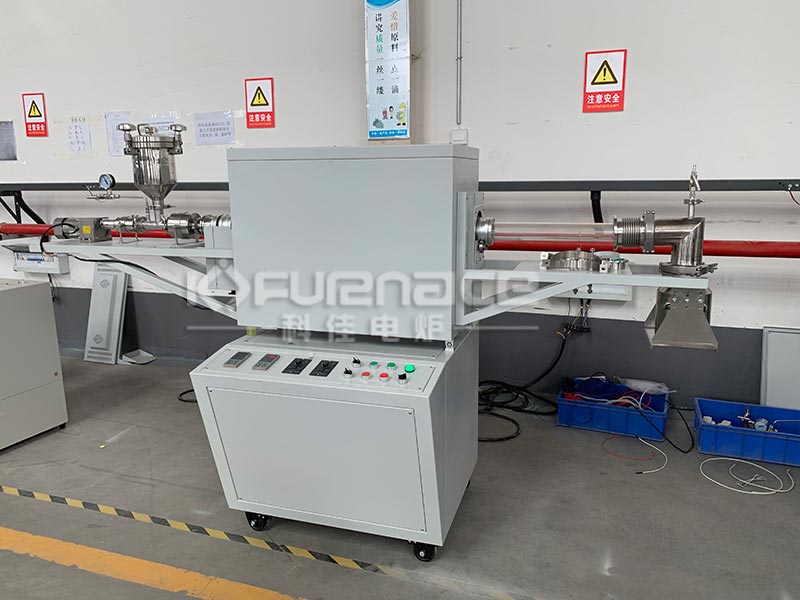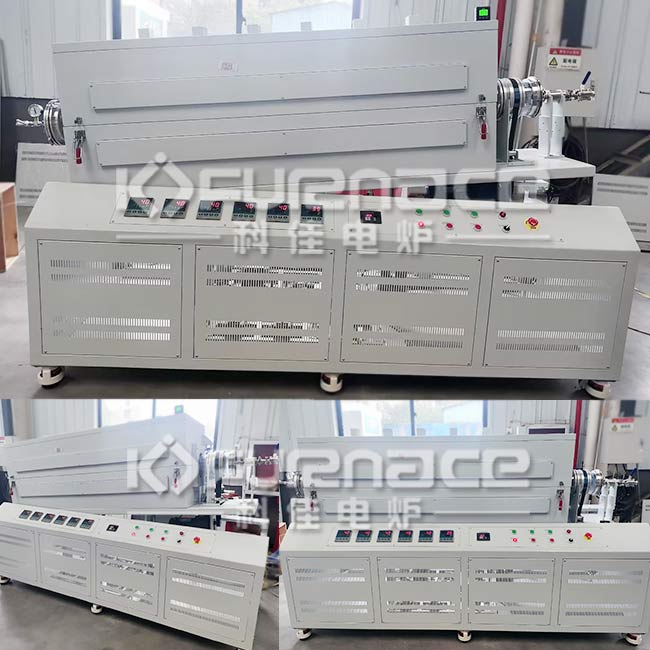As a commonly used heat treatment equipment in university laboratories and industrial and mining enterprise laboratories, the experimental multi temperature zone rotary furnace has the characteristics of high heat treatment efficiency, uniform temperature field, and intelligence. So, what aspects should be paid attention to when choosing an experimental multi temperature zone rotary furnace? Let’s take a look below!

Experimental Two Gradient Rotating Tilt Tube Furnace (Click on the image to view product details)
1. Material type and process requirements: basic adaptability
Material property matching
Determine the type of materials to be processed (such as powders, ceramics, metallurgical materials, etc.), as different materials have specific requirements for furnace materials and heating methods. For example, powder materials require anti adhesion design, while ceramic materials require uniform heating to avoid cracking.
Clarify the process parameters: temperature range (e.g. maximum required 1200 ℃ or 1700 ℃), heating rate (recommended 0-20 ℃/min), insulation time, etc., to ensure that the equipment performance meets the experimental requirements.
Production and efficiency requirements
Select furnace tube volume and heating power based on the experimental scale. For example, when dealing with a large amount of powder, it is necessary to choose a furnace type with a heating zone length of ≥ 600mm to ensure uniform heating.
2. Furnace type and structural design: functional flexibility
Multi temperature zone configuration
Independent temperature control capability: The multi zone rotary furnace needs to support independent temperature setting, heating rate, and holding time for each temperature zone to adapt to complex processes such as staged sintering and annealing. For example, the three temperature zone design can simultaneously achieve rapid heating, constant temperature insulation, and cooling control.
Number and layout of temperature zones: Select the number of temperature zones (such as dual temperature zones, triple temperature zones) and layout method (such as series or parallel) according to experimental requirements to ensure controllable temperature gradients.
Furnace tube material and size
Material selection: Select materials based on temperature and chemical environment. Quartz tubes are resistant to high temperatures and have good chemical stability, making them suitable for routine experiments; Corundum tube is wear-resistant and corrosion-resistant, suitable for special chemical treatment; Metal pipes (such as stainless steel) are suitable for specific industrial scenarios.
Pipe diameter and length: The pipe diameter should match the sample size (such as 60mm or 127mm), and the length should cover the heating zone (such as 600mm heating zone with 1200mm furnace tube) to ensure that the sample is fully heated.
Rotating and tilting mechanism
Adjustable speed: The furnace tube speed (such as 1-10 rpm/min) affects the uniformity of material mixing and needs to be adjusted according to the process.
Adjustable tilt angle: Some furnace types support tilting of the furnace body (such as -5 ° -20 °), which facilitates sample loading and unloading and reactant discharge.
3. Performance parameters: accuracy and stability
temperature control accuracy
Select equipment with temperature control accuracy within ± 1 ℃ to ensure experimental reproducibility. For example, a furnace type using fuzzy PID control and self-tuning regulation technology can reduce temperature fluctuations.
Uniformity of temperature zone
The length of the heating zone determines temperature uniformity. A longer heating zone (such as 600mm) provides a more uniform temperature field, suitable for experiments that require high temperature uniformity (such as crystal growth).
Heating element and temperature measurement method
Heating element: Resistance wire is suitable for low temperature (≤ 1200 ℃), silicon carbon rod is suitable for medium high temperature (≤ 1400 ℃), and silicon molybdenum rod is suitable for high temperature (≤ 1700 ℃).
Temperature measurement method: N-type thermocouples are suitable for conventional temperatures, while S-type or B-type thermocouples are suitable for high-temperature environments to ensure temperature measurement accuracy.
4. Safety and Environmental Protection: Operational Reliability
Security protection function
Essential functions: Over temperature alarm, leakage protection, power-off when opening the door, emergency shutdown, etc., to prevent high temperature, high voltage or leakage risks.
Sealing design: Magnetic fluid flanges or stainless steel sealing flanges are used to ensure safe operation of furnace tubes in vacuum or atmospheric environments.
Environmental Protection and Energy Consumption
Choose energy-saving designs (such as double-layer air-cooled structure, vacuum adsorption molding insulation materials) to reduce energy consumption and operating costs.
Prioritize low emission equipment that meets laboratory environmental requirements.
5. After sales service and budget: long-term value
After sales service content
Confirm whether the manufacturer provides installation and debugging, operation training, warranty period (such as 1 year), and maintenance response time to ensure long-term stable operation of the equipment.
Budget and cost-effectiveness
Due to significant differences in brand, model, and performance, prices need to be balanced between budget and demand. For example, basic rotary furnaces are suitable for small laboratories with limited budgets, while high-end ones (such as multi zone and high-precision temperature control) are suitable for research institutions or enterprises.
6. User reviews and case references
Refer to feedback from other users to understand the actual performance of the device (such as temperature field uniformity, failure rate) and the manufacturer’s service response speed.
Case reference: Some models of rotary furnaces are designed with internal lifting plates, which greatly improve the uniformity of powder sintering and are suitable for the research and development of lithium battery materials; Multiple temperature specifications (1200 ℃, 1400 ℃, 1700 ℃) and heating element options to meet different high-temperature experimental needs.

Customized six temperature zone high-temperature rotary furnace (click on the image to view product details)
In general, when selecting an experimental multi temperature zone rotary furnace, attention should be paid to the above aspects. Before choosing, you can communicate with relevant technical personnel about the parameters you need, so as to customize a multi temperature zone rotary furnace that is more suitable for your experiment!Click to learn more tube furnaces! Or click on online customer service to learn more about product information!